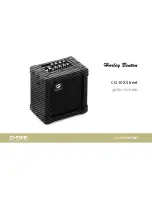
Chapter 6 Organ | 23
The Nord Stage 2 EX features three organ models, all digitally modeled;
a tonewheel/B3 organ and two transistor organs (Vox and Farfisa).
The Organ section features three main areas:
• The Drawbar section where you set-up the basic organ sound.
• The Percussion area is where you control the percussion effect (avail-
able to the B3 organ model only).
• The Vibrato/Chorus area is where you select the chorus and/or
vibrato effect depending on the selected organ model.
Drawbars and buttons
The drawbars on the Nord Stage 2 EX are represented by buttons and
LED chain graphs instead of ordinary mechanical drawbars. This gives
you a big advantage: when you change preset or program, the correct
drawbar settings are recalled immediately and shown by the LEDs. It’s
very easy to get the hang of changing the drawbar settings in a natural
way with the buttons.
The drawbars behave similar to their mechanical counterparts. On the
B3 and Vox models you “pull out” and “push in” the drawbars using the
drawbar buttons.
The buttons are special in the way that they auto-increment/decrement
the drawbar value when they are held down. If you hold a drawbar
button the corresponding drawbar setting will continue to increment or
decrement (within its range) until you release the button.
The drawbars can be Morph controlled, if you want to make dra-
matic changes with for example the Wheel or a control pedal.
While holding a drawbar button, you can press its sibling button to
momentarily auto-increment/decrement in the opposite direction.
With the Farf model, drawbar buttons act as switches, toggling each
register on or off.
Selecting The Organ Model
You select which model to use with the Organ Model button. Only one
model can be used at a time in a Program.
The B3 Model
The B3 model is based on a digital model of the classic electro-
mechanical tonewheel organ. This simulation utilizes innovative and
advanced methods to capture every nuance of the original sound, here
are some examples:
• An extremely accurate digital model of the original chorus and vibrato
scanner.
• Modeling of the individual random contact bounces for each har-
monic.
• Modeling of the unique frequency characteristics of the built-in pre-
amplifier, which forms the “body” of the sound.
• Simulation of the energy robbing on the tone wheels that results in
the typical “compressed” sound.
• Authentic tuning of the tonewheels according to the original design.
• Extremely fast keyboard response.
• Full polyphony.
6
Organ
Summary of Contents for NordStage2 EX 88
Page 60: ......
















































